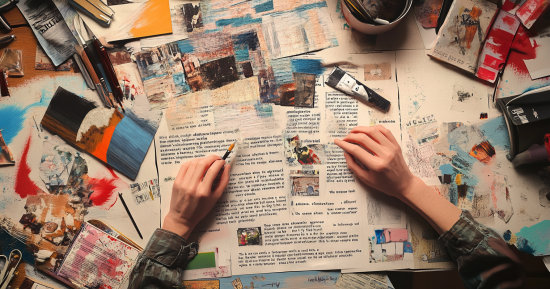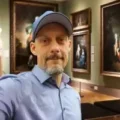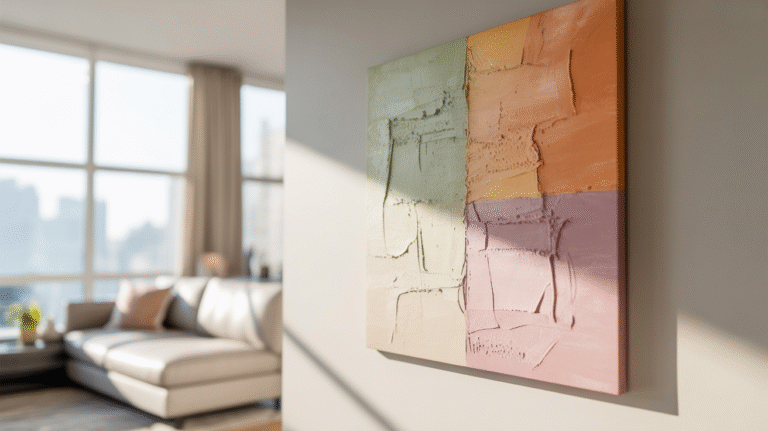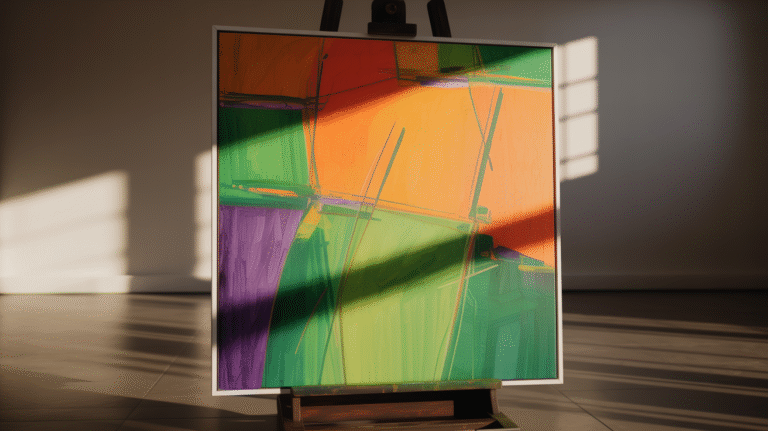Are you looking to dive into abstract art and unleash your inner artist? Understanding how to create abstract art can seem overwhelming, but it can be rewarding and liberating once you become familiar with it. Let’s explore some techniques and tips to get you started on your journey to mastering abstract art.
Abstract Art
To begin with, it’s crucial to embrace the mindset that abstract art is all about expressing emotions, ideas, and concepts rather than focusing on creating a precise representation of objects or subjects. This freedom allows you to experiment with colors, shapes, and textures, resulting in a unique piece that reflects your creativity. Don’t be afraid to step outside your comfort zone and explore new methods as you learn and grow.
When working on an abstract painting, be open to various techniques and approaches, such as using geometric shapes and embroidery to make a statement. Each method you experiment with will help you develop your style and improve your skills in the enchanting world of abstract art.
Understanding Abstract Art

History of Abstract Art
Abstract art is a fascinating expression that refuses to conform to traditional rules and aims to evoke various emotions, even if it may not depict realistic images. When venturing into creating abstract art, it’s essential to understand its origins. The 20th century marked the rise of abstract art when numerous artists started to break away from formal teachings and embrace their unique methods. As a result, abstract art has evolved remarkably over time, with numerous artists making valuable contributions to its development.
Key Characteristics
To make your abstract art, it’s essential to grasp some of its key characteristics to better understand the art form. Here’s a quick overview of some features commonly observed in abstract art:
- Shapes: Formal and geometric shapes, such as squares, circles, and triangles, are often used as building blocks for abstract pieces. These are combined and arranged in various ways to create visually compelling compositions.
- Colors: Abstract art uses various colors to evoke emotions, enhance visual interest, or convey the artist’s thoughts. Bold, contrasting colors are often employed to make a statement, while subtle hues create a more subdued atmosphere.
- Lines: Lines are an essential element in many abstract works, serving different purposes, such as separating areas, creating movement within the piece, or leading the viewer’s eye. Lines can be thick or thin, straight or curved, and assume any imaginable form.
- Texture: Abstract artists can create unique and intriguing textures on the surfaces of their pieces using different techniques. This can be achieved through the use of tools like brushes and palette knives or mediums like gels and pastes.
To create your abstract art, it can be helpful to start by exploring these key characteristics and experimenting with how to incorporate them into your work. For instance, artists use various techniques to create meaningful abstract paintings, mixing traditional means with more experimental ideas. By exploring the history and characteristics of abstract art and understanding how it’s made, you’ll be better prepared to produce your own captivating pieces. Remember to maintain a friendly tone with your approach and let your imagination guide you. Happy creating!
Preparing Your Workspace

Choosing Your Materials
Before starting your abstract art project, selecting the right materials is important. You will need the following:
- Paint: Acrylic or watercolor paint for their versatility and vibrant colors. Choose a variety of shades and tones that inspire you.
- Canvas: Pre-stretched canvas or canvas paper, depending on your preference.
- Brushes: Various sizes of brushes are essential for different techniques and details.
- Palette knife: Great for creating textures and mixing paints.
- Mixing palette: A plastic or disposable palette for mixing your colors.
- Water container: A cup or container for cleaning brushes between color applications.
(Optional):
- String or yarn: Can be used for the string pull technique.
- Gold leaf: Adds a touch of elegance and interest to your piece.
- Rubbing alcohol: Useful for creating alcohol ink effects in your painting.
Remember, when choosing materials, it’s always better to invest in professional quality art supplies rather than opting for lower quality options to ensure the longevity of your masterpiece.
Setting Up the Space
Creating abstract art can be a messy process, so it’s crucial to prepare your workspace accordingly:
- Cover your work surface: To protect your table or floor, use a waterproof tablecloth, a large sheet of plastic, or old newspapers.
- Gather all materials: Organize your chosen materials, ensuring everything is easily accessible.
- Wear protective clothing: Since paint splatters and drips are typical, wear old clothes or an apron to avoid ruining your favorite garments.
- Arrange adequate lighting: Ensure your workspace is well-lit, with natural light or additional lamps, to see colors and details accurately.
- Set up a place for drying: Designate a safe, flat area for your artwork to dry undisturbed.
Preparing your workspace in advance allows you to dive into the creative process without interruptions or potential damage to your surroundings. Now you’re all set to create your very own abstract art masterpiece!
Developing Your Technique

Exploring Color Theory
To create captivating abstract art, it’s essential that you understand color theory. Color theory teaches you how to mix and combine colors to create harmony, contrast, and visual interest in your artwork. Begin by getting acquainted with the color wheel, which includes primary, secondary, and tertiary colors.
Learning the relationships between colors is key. For example, complementary colors are colors that are opposite each other on the color wheel. They create strong contrasts when used together. Analogous colors are colors that are next to each other on the color wheel and create a harmonious effect when combined.
Experiment by:
- Mixing and layering colors
- Using different color schemes (e.g., complementary, monochromatic, triadic)
Experimenting with Texture
Adding texture to your abstract art can give it depth and richness. There are numerous ways to experiment with texture, such as:
Paint application techniques:
- Thick impasto: Using heavy body acrylics or thick oil paints to create raised areas on the canvas
- Drips and splatters: Diluting your paint with water or using acrylic inks to create drips, runs, or splatters
Tools for creating texture:
- Palette knives
- Sponges
- Brushes with different stiffness and size
Adding elements to your paint:
- Sand or fine grit
- Paper or fabric scraps
Remember, when experimenting with texture, be open to trying new techniques and tools. Stay curious and observe how the paint behaves on the canvas. As you continue to explore color theory and experiment with texture in your abstract art, your unique style and technique will develop naturally.
Creating Your Abstract Art

Finding Inspiration
When starting your abstract art journey, look for inspiration from various sources around you. Explore nature, architecture, or even emotions to tap into ideas for your artwork. You can also gather insights from other abstract artiststo boost your creative process.
Composition and Design
Before diving into painting, it’s essential to understand some fundamental design principles like unity and variety. These principles will help you create a visually appealing and balanced artwork. One way to achieve this is by using structures such as grids or the rule of thirds. Consider starting with a basic shape or dividing your canvas into thirds, then developing your design around that structure.
Experiment with different techniques to incorporate texture and depth into your work:
- Thickening mediums like cold wax or Liquin Impasto
- Layering paint
- Scraping or sgraffito
- Collage elements
While working on your composition, play with value, shapes, and colors to create a dynamic piece. Remember, it’s essential to maintain a balance between these elements.
Applying the Paint
As you begin to apply paint onto your canvas, there are multiple approaches to consider:
- Freeform painting: Start by spontaneously applying paint and let your intuition guide you.
- Geometric shapes: Create a more structured composition using triangles, squares, and rectangles.
Don’t be afraid to take risks and try various techniques. Also, remember that it’s common to make adjustments and alterations during the process. It’s all part of the journey when creating abstract art.
In the end, keep experimenting, stay open to new ideas, and enjoy the creative process as you refine your abstract art skills.
Finishing Touches and Preservation
When it comes to abstract art, adding the right finishing touches and preserving your artwork are crucial steps to ensure its longevity and visual appeal. Let’s discuss some valuable tips that can help you give your abstract art a polished look.
Sealing and Protecting the Artwork
To protect your abstract painting, it is essential to apply a sealant or a protective coating. This step helps shield the artwork from external factors such as dust, moisture, and UV rays, thereby preventing discoloration and preserving its vibrancy for years to come. Here are some tips to help you seal and protect your artwork:
- Choose the correct sealant: Sealants come in various forms, such as spray varnishes, brush-on varnishes, and cold wax. Select a sealant that is compatible with the materials you have used in your painting, whether it is acrylics, oils, or mixed media. For example, for acrylic paintings, a specific acrylic varnish would be most suitable.
- Glossy or matte finish: Decide on the desired finish for your artwork – whether it should be glossy or matte. Glossy finishes tend to enhance colors and make them appear more vivid, while matte finishes provide a non-reflective surface that displays the texture of the paint more prominently. Remember, it’s all about your personal preference and what complements your abstract art best.
- Proper application: Before applying the chosen sealant, ensure that your painting is completely dry. Prepare the working surface by placing your artwork on a flat, dust-free surface, and stay in a well-ventilated area. Spray or brush the sealant evenly, taking care not to leave any visible brush strokes or drips. Allow the sealant to dry for the recommended time mentioned on the product’s label.
By following these practical tips on finishing touches and preservation, you can ensure that your abstract art remains well-protected, visually striking, and ready to be admired for years to come.
FAQ – Abstract Art
Do I need unique materials to create abstract art?
No specific materials are required. You can use paint, pencils, markers, or even digital tools.
Can beginners make abstract art?
Absolutely! Abstract art is accessible to all skill levels. Just start creating and see where your imagination takes you.
How do I know when my abstract art is finished?
It’s finished when you feel the composition and balance reflect your vision. Trust your instinct
Should I plan my abstract art piece?
Planning can help, but many abstract artists prefer to work intuitively. Try both approaches to see what suits you.







[…] Abstract Art […]
[…] You don’t know, how to make Abstract Art? Take this way: How to Make Abstract Art: Simple Techniques for Everyone […]